| Article ID | Journal | Published Year | Pages | File Type |
|---|---|---|---|---|
| 10492976 | Journal of Business Research | 2015 | 6 Pages |
Abstract
Bayes theorem is the normative method for revising probability forecasts using new information. However, for unaided forecasters its application can be difficult, effortful, opaque and even counter-intuitive. The study proposes two simple heuristics for approximating Bayes formula while yielding accurate decisions. Their performance was assessed where a decision is made on which of two events is most probable and where a choice is made between an option yielding an intermediate utility for something that is certain or for a gamble which will result in either a worse or better utility (“certainty or risk” decisions). For “most probable event” decisions the first heuristic always results in the correct decision when the reliability of the new information does not depend on which event will occur. In other cases, the second heuristic typically led to the correct decision for about 95% of “most probable event” decisions and 86% of “certainty or risk” decisions.
Related Topics
Social Sciences and Humanities
Business, Management and Accounting
Business and International Management
Authors
Paul Goodwin,
